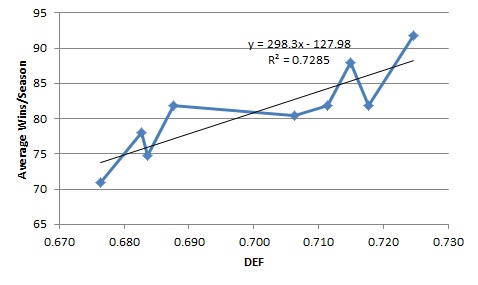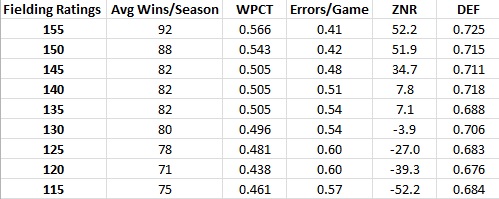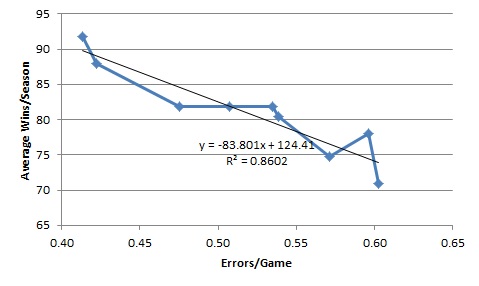We’ve previously used Out of the Park Baseball (OOTP) to test out theories on hitting, such as how well OPS and Runs Created predict team win totals. The sabermetrics folk have made great strides in trying to create meaningful statistics for fielding, including Ultimate Zone Rating (UZR), Total Zone (TZ), and Defensive Runs Saved (DRS). We won’t go into great detail about what each of those do – FanGraphs does a better job than we ever could. But it’s not as easy to take the results of any of these statistics and translate it to what matters most – a player’s contributions to a team’s win total.
Baseball Reference does include DRS into its WAR calculations, but there’s always a danger when we’re extrapolating one step beyond any one particular calculation. For instance, DRS provides an estimate of runs saved which is then used in a calculation to estimate how many additional wins you might expect. But each of those calculations will have an error range and will be impacted by a myriad of other factors. We were looking to use OOTP for a more direct way to see how fielding impacts a team’s win total.
Our first foray simply looked at teams with different overall fielding capabilities. OOTP uses several different ratings for fielding, available when editing player characteristics. For instance for an infielder there is Infield Range, Infield Error, Infield Arm, and Turn Double Plays. Each rating is based on a scale of 1-250.
We set up an 11-team league, with each player on each team having the same overall fielding ability but with each team varying in their abilities. So for instance one team had each player with a “1” rating for each fielding ability, while another team had each player with a “250” for each fielding ability. All players had the same league average ratings for hitting. All pitchers were equivalent pitchers with average ratings, and an average ground/fly ratio.
We simmed three seasons (with all injuries and player development turned off). Of course, the better fielding teams did better, but it was somewhat surprising as to how much better they did. The team made up of the highest rated fielders average a record of 113-49 with the team made of the lowest rated fielders went and average of 42-120.
What was also interesting were the number of errors committed per game. The best fielding team committed only .28 errors per game with the worst fielding team 1.31. We would have thought with everyone on the team having a 1 rating for every fielding attribute that they would have kicked and thrown the ball around more. But they still on average gave one extra out to the other team than the best fielding team. By comparison in 2014 the Reds had the fewest errors (.62 errors/game) while the Indians had the most (.72 errors/game).
The more important difference seemed to be in balls the fielders didn’t get to due to range issues. Defensive efficiency for the best fielding team was .768 while for the worst it was .606. In 2014 the best team DEF was .712 by the Reds and the worst was .672 by the Twins.
So let’s try to extrapolate this to some meaningful MLB differences. Since the original league took fielding ratings to extremes, we created a league with teams whose defensive ratings more closely resembled MLB. In this 9-team league, fielding ratings for all players ranged between 115 and 155 (the range in the original sim which more closely resembled MLB fielding stats).
Again we simmed three seasons, and the difference between the first and last place teams was again quite large. The top fielding team went on average 92-70 while the worst fielding team went 71-91 – a whole 21 game difference. Here are the results:
Along with charts for errors/game compared to wins and team DEF compared to wins.
There are certainly many factors that can influence these results – most notably around balls hit in play (e.g. increased strikeout rate, HR %). But this certainly does suggest that getting a good grasp on accurately rating fielders can have a big impact on a team’s win total.







